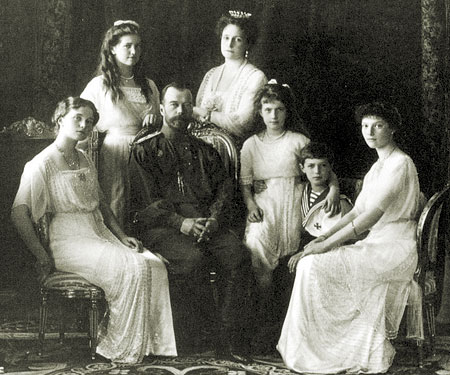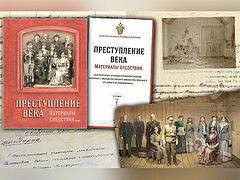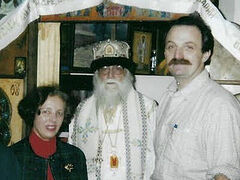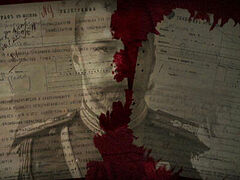This article, originally published by the Ekaterinburg Diocese, discusses the veneration of the Royal Martyrs that began in Ekaterinburg in the late 1980s, and which eventually led to their formal canonization by the Moscow Patriarchate in 2000. The Royal Family had already been canonized by the Russian Orthodox Church Outside of Russia in 1981. It is interesting to note that, while some people debate about whether the members of the Royal Family are more properly considered Martyrs, as ROCOR canonized them, or Passion-Bearers, as the Moscow Patriarchate canonized them, in this article, and in many others from the Russian Orthodox Church, they are, in fact, referred to as both, and the terms seem to be used more or less interchangeably.—Trans.
***
We don’t know whether the sin of regicide has been forgiven us…
In previous conversations with Alexei Anatolievich Kuzmin, the compiler of the biography of the Holy Royal Passion-Bearers, we said that many simple people in the Urals venerated the Royal Martyrs from the very first days after their deaths. The veneration of the Royal Family began in Ekaterinburg before there were any churches in their honor, before they were canonized. People would simply go to the place where the Ipatiev House had stood, and cleaned up the waste on the vacant lot that the townsfolk used for walking their dogs.
And yet, July 16, 1989, proved to be a special date in the history of the capital of the Urals. In the evening, on the vacant lot where the Ipatiev House once stood, people began to gather. For the first time, the people’s prayers for the Royal Martyrs openly rang out. The city authorities reacted to this event as to a dangerous act of civil disobedience. Many of those who prayed at the moleben were beaten and arrested. But despite the resistance of the authorities, the popular veneration of the Royal Family grew stronger. The following year, thousands of people gathered on the day of the remembrance of the Martyrs. At night, two priests celebrated a penitential service.
On August 18, 1990, the first wooden cross was erected on the site where the Ipatiev House had been, and the faithful began praying once or twice a week there, reading akathists.
On August 25, His Eminence Vladyka Melchizedek served a panikhida for the Royal Family for the first time at the Royal Cross. The cross stood for two weeks and then was broken by unknown malefactors, but the faithful restored it to its original form.
“I remember well,” says Alexei Kuzmin, “how the atheists tried to desecrate this cross and even put a bomb under it. But the cross remained, and for many years it was the only visible sign of the veneration of the murdered members of the Royal Family in the city. The memorial cross is a small structure that could also be called a mini chapel.”
On October 5, 1990, the venerators of the Royal Martyrs set up a new metal cross, and something miraculous happened while it was being erected. A bright light came from the sky, through the rainy weather, flowing through a funnel formed by the rotating clouds.
Despite the fact that quite a lot of time has passed, Alexei Kuzmin remembers that day well. Here’s how he tells the story:
“The sign lasted for about twenty minutes, and then the sky gradually closed, and the ray of light disappeared. And during that time, many things in my life changed. For the first time in my life, I felt and realized that God exists. The fear of God appeared within me, which I never had before.”
Five days after this sign, the Sverdlovsk City Council decided, “due to numerous requests from residents of the city and public organizations,” to allow the installation of a “memorial symbol on the site of the execution of the Royal Family.” It also decided to transfer the small plot of land to the Ekaterinburg Diocese.
In the Royal Days of 1991, a procession was held in the city for the first time, from the Ascension Church to the Royal Place, where Archbishop Melchizedek of Ekaterinburg and Kurgan served a great panikhida for the innocently murdered. At night, at the hour of the murder, two priests served a moleben with the blessing of water at the Royal Cross. This is what Vladyka Melchizedek wrote: “In 1991, the Ekaterinburg Diocese participated in the Royal Days for the first time. Guests came from other cities, including clergy.” Since then, the Russian Orthodox Church began openly venerating the Tsar. In 1991, Ekaterinburg was restored to its historical name, and after a long period of inactivity, services began again in the oldest church in the city, the Church of the Ascension of Christ, which was a special symbol of the spiritual life of the city. Let me remind you that the famous Congress of Compatriots was held the same year, including the famous writer Vladimir Soloukhin, who is now unfortunately reposed. He came to Ekaterinburg with a group from the Congress, and on July 17, they erected a memorial cross in memory of the Royal Family on Ganina Yama. That is, the very idea of the “Royal Place” began to mean not just the place where the house of the engineer Ipatiev had stood, where the Royal Passion-Bearers met their martyric end, but also the place where the remains of their bodies were destroyed.
Of course, the place of their murder is a holy place, but the place where their bodies were destroyed, where perhaps some parts of their bodies may have remained, is also holy. And there have been many signs and indications, Heavenly proofs from above, that these places are holy. People saw the fiery cross, and the pillars of fire; some saw images of the members of the Royal Family… And this was a spiritual turning point for many.
If we talk about miracles, we have to note that they can be different for different people. But if a man comes to God and sees his sins, then however strange the miracle may seem to him, he believes that it is from God. Because this is a spiritual joy that any Christian should feel and understand. There are many miracles now, many myrrh-streaming icons, and many people have even stopped paying attention to them, forgetting that the Lord knocks for everyone in his own time. For believers, this strengthens them in their faith; for non-believers, it’s “madness,” as said the Apostle Paul. Many who were non-believers before, after seeing some explicit miracle, come to God—but Christ wants people to believe in Him not for a miracle, but simply to believe. Therefore, some may have been given a miracle in life, and some not. And blessed is the man who believes in God without one.
But apparently it was God’s providence that there were many miracles with the Royal Family. Alexei Kuzmin recalls the first Ekaterinburg visit of Grand Duchess Olga Nikolaevna Kulikovskaya-Romanova in 1991:
When we arrived at Ganina Yama, it was raining heavily. But as soon as Olga Nikolaevna approached the memorial cross, the bright sun peeked out, and everyone saw a bright pillar of light descending from the sky. Everyone froze; everyone was weeping. A year later, in 1992, Vladyka Melchizedek himself made the procession from Shuvakish to Ganina Yama, where the first hierarchical moleben was served. But then the exact opposite happened: The clear, sunny sky was covered by a cloud, and with the first words of the prayers, a heavy downpour began. After the end of the moleben, Vladyka said: “We wept, and nature wept with us.” Then the sun came out again, and the people, soaked to the bone, got completely dry as they walked back to the Shuvakish Station.
On September 23, 1992, on the site of the future Church-on-the-Blood, Vladyka Melchizedek, Archbishop Seraphim of Penza and Kuznetsk, and Bishop George of Chelyabinsk and Zlatoust solemnly laid the foundation stone with a particle of the holy relics of Righteous Simeon of Verkhoturye. Olga Nikolaevna Kulikovskaya-Romanova came to Ekaterinburg for the laying of the foundation stone. She conveyed the will of her then-living spouse, Tikhon Nikolaevich, to give the Russian Orthodox Church the Three-Handed (Troeruchista) Icon of the Mother of God that was brought to him by a friend, a loyal officer of Empress Maria Feodorovna, the mother of the Tsar-Martyr. It was brought from Ekaterinburg: He found the icon thrown out in the yard of the Ipatiev House. There was a single day, July 25, 1918, when there were no guards near the Ipatiev House, and on that day, anyone who wanted could come and take whatever they wanted. There’s no doubt that this icon was in the Ipatiev House and is a “living” witness to the prayers of the Tsar and the members of his family.
Tikhon Nikolaevich was certain that a church would be built on the site of the murder of the Royal Family, and bequeathed to transfer the Three-Handed Icon to this church.
It was given to the Church-on-the-Blood in 2003. The holy image was greeted by many people in Ekaterinburg in a procession. There was some continuity in this, too. The icon, which went from Russia to Denmark first, then to Canada, returned to Russia many decades later. Many still remember the sad incident with this icon: It was stolen right from the church—at first it had been right on the analogion.
The faithful were in shock: Has the blessing of the Imperial House really left us? Could we really not protect this sacred item?
For three days, no one heard anything about the fate of the icon. Colonel Romanov, who was investigating the matter, told the collectionists quite harshly: “If the icon isn’t returned in three days—it’s on you.” And the icon was quickly returned through a front man. Now a beautiful icon case made of Ural gems has been made for the Three-Handed Icon.
On January 25, 1993, the Ekaterinburg City Council and the media received an appeal from Archbishop Melchizedek of Ekaterinburg and Kurgan where the hierarch of the Russian Orthodox Church-Moscow Patriarchate officially called the Royal Martyrs saints for the first time: “Among the victims are the canonized holy New Martyrs and Confessors of Russia, headed by the right-believing Tsar-Martyr St. Nicholas II Alexandrovich. Tsar St. Nicholas is not yet canonized by the Patriarchal Church, but he is a locally venerated saint in Ekaterinburg, and we, residents of the city, are witnesses of the mass Church veneration of him, his august family, and the host of all the holy New Martyrs of Russia.”
On the night of July 17, 1993, the first Divine Liturgy was held on the site of the martyric end of the Royal Family, with the blessing of Archbishop Melchizedek of Ekaterinburg and Verkhoturye. It was served by Fr. Alexander Nikulin and attended by the Orthodox writer Nun Nektaria from California, to whose pen belong several books on the Royal Family. Thus was born the annual tradition of serving Divine Liturgy at the time of the murder of the august Sufferers. After the Divine services on Holy Pascha, the Nativity of Christ, the Baptism of the Lord, and Holy Saturday, the services at this holy place became a new Church celebration, the highlight being the nighttime Divine Liturgy. Since then, the remembrance of the Royal Family, in fact, has been a great feast for us. In its meaning, this day is close to the celebration of the beheading of St. John the Baptist: a great feast, but a strict fast. We’re still in such a state that we need to show more repentance. The consequences of the terrible sin of regicide are still upon us—we don’t know whether this sin has been forgiven us.
In 1993, there was organized veneration of the Royal Family for the first time, and Tamara Nikitichna Voronina, People’s Artist of Russia, prepared a literary composition, The Last Tsar, which was published for the masses. It included the prophecies of St. Seraphim of Sarov about the fate of the Royal Family, and poems by Marina Tsvetaeva dedicated to the Empress. This work has become a special “spiritual lamp” for many people in honoring the Royal Family in the Urals.
On December 28 of the same year, the Holy Synod of the Russian Orthodox Church, chaired by His Holiness Patriarch Alexei II, testified that “our people, who are going through the trials imposed by God for the sins of apostasy, regicide, and civil unrest, and who are repenting of these sins, need a visible sign of repentance,” and blessed the construction of a memorial Church-on-the-Blood in honor of All Saints Who Have Shown Forth in the Russian Land.
For the birthday of Tsar Nicholas the Passion-Bearer, May 19, 1994, a chapel canopy was erected over the memorial cross, crowned with a cupola with a cross, and Vladyka Nikon served Liturgy there in Bright Week and communed the faithful. Many different people came to the cross—true believers and random passers-by, who, seeing people praying there, stopped and asked what was going on. Some wondered why people venerate the Royal Family. At that time, only negative things were said and written about Emperor Nicholas II. Now there are many books and archival documents that allow anyone to figure out for himself what’s what, to think about it and draw some conclusions.
We know how powerful Russia was under the Tsar and what happened to it when the royal authority was gone. In the person of the Tsar, we had a father. A family can’t live without its father, otherwise it’s an incomplete family. As they correctly say, the family is the building block of the whole of society. And as it is in the state, so in the family, and vice versa. No father—no family. Figuratively speaking, the Soviet government played the role of stepfather—a stern stepfather who didn’t love but rather flogged his adopted child, who deserved it for his sins. And when this stepfather was gone … it gives the feeling that we’ve simply become an abandoned child.
Foreigners tell us: “You Russians can’t live without a tsar.” Our country is going through a rather difficult time right now. Apparently, the venerable Elder Seraphim spoke about this time, that “the monks will be like laypeople, and laypeople like demons.” The tsar isn’t just the state power; the tsar is the foundation of the people. The people are happy when they have a tsar. And the Russian people were the only people in the world who carried this idea: faith, reflected in state administration as an image of the Heavenly Kingdom and the earthly kingdom. Therefore, the first task from both foreign states and the Bolshevik God-fighters was to break the tsarist power in Russia.
That’s why there was a special malice towards the clergy, a special malice in the destruction of churches: Because it was precisely there that everything in the foundation had to be killed.
“But the most interesting thing,” notes Alexei Kuzmin, “is that the veneration of the Royal Family in Russia began precisely here, in the Urals, in such a ‘godless’ region compared to Central Russia. The memory of the Tsar revived many here. I just know and see that many have come to Christ through the Tsar. I can say for myself: If not for the Tsar, if not for the Royal Family, I don’t know how I would have come to God.”
In 2000, the Jubilee Bishops’ Council of the Russian Orthodox Church, held in Moscow from August 13 to 16, glorified the Synaxis of the Holy New Martyrs and Confessors of Russia. The Holy Royal Passion-Bearers were among the first to be named. It was officially decided to canonize the members of the Royal Family, although the people had already been venerating them as saints for a long time, and this canonization was simply a confirmation of a fact that already existed by itself.
The veneration of the Holy Royal Passion-Bearers is the only way we can justify ourselves before God. Our region can be saved precisely by the memory of the Royal Martyrs. It’s not without reason that people come here from all across Russia and abroad, seeking to pay off their debt to the Sovereign, to erase their guilt with their prayers and processions. And they receive great spiritual joy from this, a feast for the soul—such Paschal grace is given to people here.





